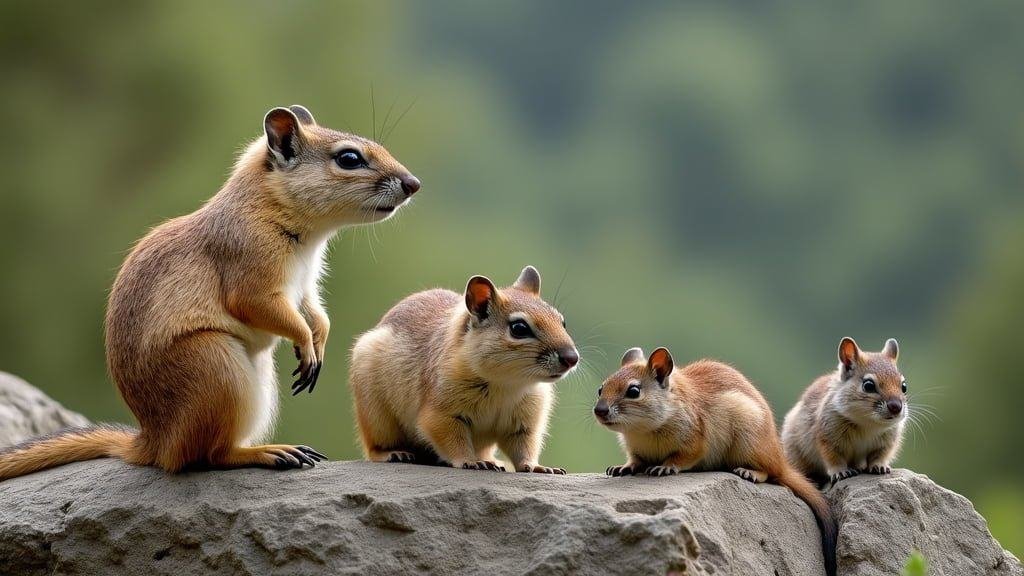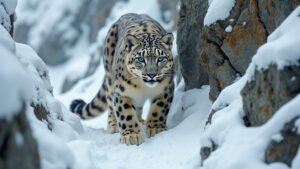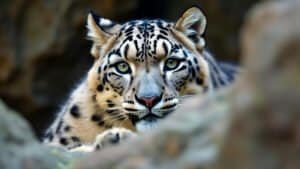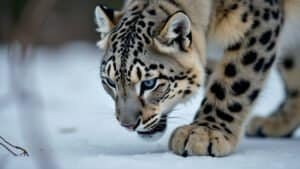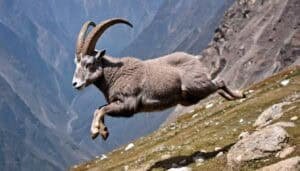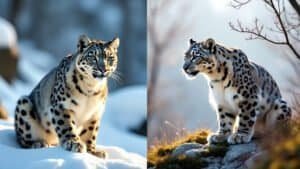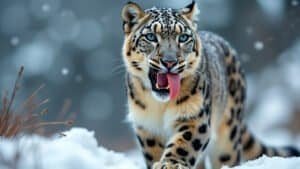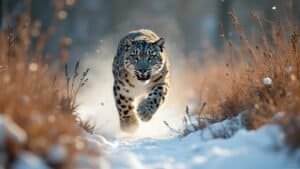Introduction
Snow leopards, known for their elusive nature and striking appearance, rely heavily on the availability of prey in their mountainous habitats. While larger prey such as blue sheep and ibex are often highlighted, small mammals like pikas, marmots, and rodents also play a crucial role in their diet
This article explores the significance of small mammals in the diet of snow leopards, examining the types of small prey they consume, how these animals compare to larger prey, and the impact of seasonal changes on their availability
Additionally, we will look at the specialized adaptations snow leopards possess for hunting these smaller animals
Common Small Mammals Preyed Upon by Snow Leopards
Snow leopards inhabit some of the most rugged and remote regions in the world. Their survival in these harsh environments depends significantly on their ability to hunt and capture prey, including various small mammals
Although these small creatures may not be as impressive as larger ungulates, they are vital to the snow leopard’s diet, especially when larger prey is scarce
Pikas and Their Role in Snow Leopard Diet
Pikas are small, herbivorous mammals found in the rocky terrains of the mountains where snow leopards dwell. Weighing between 4 to 7 ounces, these rabbit-like creatures are a common prey item for snow leopards, particularly in the alpine regions of Central Asia
Pikas are abundant in these areas and are known for their distinctive, high-pitched calls. Their populations are stable enough to provide a reliable food source, especially during the warmer months when they are most active
A study conducted by the Wildlife Conservation Society (WCS) in the Himalayas found that pikas constitute a significant portion of the snow leopard’s diet in regions where larger prey is less accessible
The pikas’ burrowing habits and agility pose a challenge to predators, yet snow leopards have developed remarkable skills in stalking and capturing these small mammals, making them a critical component of their diet
Marmots as Key Prey in High Altitudes
Marmots, large ground squirrels weighing between 5 to 11 pounds, are another important small mammal species in the diet of snow leopards
Found in high-altitude environments, marmots hibernate for several months of the year, but during the summer, they are one of the most hunted animals by snow leopards. The abundance of marmots during these months helps sustain snow leopards, particularly in regions where other prey is scarce
Research from the International Snow Leopard Trust has shown that in certain areas of the Tibetan Plateau, marmots can make up to 20% of the snow leopard’s diet during the summer
Their large size relative to other small mammals provides substantial nutritional benefits, allowing snow leopards to conserve energy for the harsher winter months. The hunting of marmots is a skillful task, as these animals are vigilant and quick to retreat to their burrows, requiring the snow leopard to be both patient and precise
Rodents and Other Small Mammals in the Diet
In addition to pikas and marmots, snow leopards also prey on a variety of other small mammals, including rodents such as voles and hamsters. These smaller creatures are particularly important during the winter months when larger prey may be difficult to find
Rodents are generally less nutritious due to their small size, but their abundance makes them a valuable food source for snow leopards in times of scarcity
Studies have indicated that in some regions, rodents may constitute up to 10% of the snow leopard’s diet, particularly in lower altitude areas where these mammals are more prevalent. The ability of snow leopards to adapt their hunting techniques to catch these nimble animals highlights their versatility as predators
Moreover, the presence of rodents in the diet of snow leopards ensures that even in challenging conditions, these big cats can maintain their energy levels and overall health
Snow leopards’ reliance on small mammals like pikas, marmots, and rodents underscores the importance of these creatures in maintaining the ecological balance in their habitats
By preying on these animals, snow leopards help regulate their populations, which in turn impacts the vegetation and overall health of the ecosystem
Significance of Small Mammals Compared to Larger Prey
Small mammals play a crucial yet often overlooked role in the diet of snow leopards. While these predators are known for hunting larger animals such as blue sheep and ibex, the importance of small mammals becomes more evident when these larger prey are scarce
Snow leopards exhibit remarkable adaptability in their hunting strategies, which allows them to exploit the availability of various prey sizes, ensuring their survival across diverse and challenging environments
Nutritional Value of Small Mammals
When comparing small mammals to larger prey, it’s essential to consider their nutritional value. Although a single small mammal like a pika or a vole provides far less energy than a large ungulate, they are much easier to hunt and more abundant in certain habitats
Small mammals generally have a high reproductive rate, which ensures a relatively stable food supply. The energy gained from hunting and consuming these animals can be crucial for snow leopards, especially when larger prey is unavailable or requires significant energy expenditure to hunt
Studies have shown that snow leopards may consume several small mammals in a single day, effectively meeting their caloric needs when larger prey is not accessible. While a large kill such as an ibex can sustain a snow leopard for several days, small mammals provide a more consistent food source that requires less energy to secure
This balance between high-effort, high-reward hunting of large prey and the more reliable, lower-effort hunting of small mammals is a key component of the snow leopard’s survival strategy
Frequency of Small Mammal Predation
The frequency with which snow leopards hunt small mammals varies depending on the availability of larger prey and the specific region they inhabit. In areas where large ungulates are abundant, snow leopards may rely less on small mammals
However, in regions where large prey is sparse or during certain seasons, small mammals become a critical component of their diet
Research conducted in the Altai Mountains has revealed that snow leopards may shift their diet seasonally, consuming more small mammals like marmots and pikas during the summer months when these animals are more active
This seasonal dietary shift is crucial for the snow leopard’s survival, allowing them to maintain energy levels even when larger prey is less accessible. In the winter, when small mammals hibernate or become less active, snow leopards may return to hunting larger prey, or they may rely on stored fat reserves gained from consuming small mammals in the summer
Impact on Snow Leopard Health and Reproduction
The diet of snow leopards, including the balance between small and large prey, has a direct impact on their health and reproductive success
A consistent supply of small mammals can help snow leopards maintain their physical condition, which is especially important for females during the breeding season. Adequate nutrition is critical for successful reproduction, ensuring that females have enough energy reserves to support pregnancy, lactation, and raising cubs
In years when small mammal populations are high, snow leopards may experience better overall health and higher reproductive success. Conversely, a decline in small mammal populations due to environmental changes or other factors could lead to nutritional stress for snow leopards, potentially affecting their reproductive rates and cub survival
This relationship highlights the importance of small mammals not just for the immediate survival of snow leopards, but also for the long-term viability of their populations
The interplay between small mammals and larger prey in the diet of snow leopards is a complex and dynamic aspect of their ecology
Small mammals provide a reliable food source that can buffer against the unpredictability of hunting larger prey, making them indispensable to the snow leopard’s survival in their rugged, high-altitude habitats
Seasonal Availability of Small Mammal Prey
The availability of small mammal prey, such as pikas, marmots, and rodents, is not consistent throughout the year in the high-altitude habitats of snow leopards
These seasonal fluctuations significantly impact the snow leopard’s diet and hunting behavior, requiring them to adapt to the changing conditions of their environment
Understanding these seasonal dynamics is crucial to comprehending how snow leopards survive and thrive in such harsh and variable climates
Changes in Prey Availability During Winter
Winter presents a particularly challenging time for snow leopards. The harsh weather conditions and deep snow make hunting more difficult, and many small mammals, such as marmots, hibernate or reduce their activity levels significantly during this period
As a result, the availability of small mammals as prey decreases sharply in the winter months
To adapt to this scarcity, snow leopards often shift their diet towards larger prey like blue sheep (bharal) and ibex, which are less affected by the winter conditions. However, this shift requires more energy for stalking and taking down these larger animals, which can be difficult in deep snow and rugged terrain
The reduced availability of small mammals during winter means that snow leopards must rely on their fat reserves, built up during the more bountiful summer and autumn months, to sustain themselves through the colder season
Effects of Summer Abundance on Snow Leopard Behavior
In contrast to winter, the summer months bring an abundance of small mammal prey. Pikas and marmots are particularly active during this time, foraging for food and increasing their visibility and vulnerability to predators like snow leopards
The increased activity of these small mammals during the warmer months provides snow leopards with ample hunting opportunities
During the summer, snow leopards tend to focus more on hunting small mammals because they are easier to catch and more abundant. This period allows snow leopards to replenish their energy reserves and build up fat stores in preparation for the leaner winter months
The abundance of prey in the summer also supports higher reproductive success, as females are able to obtain the necessary nutrition to support pregnancy and lactation
Researchers have observed that during the summer, snow leopards may reduce their hunting of larger prey, focusing instead on the more easily accessible small mammals
This behavioral shift is crucial for energy conservation and helps snow leopards maintain their health during a time when they are less likely to encounter the large, energy-intensive prey required to sustain them through the harsher months
Adaptive Hunting Strategies During Seasonal Shifts
Snow leopards have developed a range of adaptive hunting strategies to cope with the seasonal availability of prey. In the summer, when small mammals are abundant, snow leopards often hunt during dawn and dusk, when their prey is most active
Their keen sense of hearing and sight allows them to detect and capture these small, agile animals even in the dim light of early morning or late evening
In the winter, snow leopards may switch to a more opportunistic hunting strategy, taking advantage of any available prey, including carrion or livestock, to supplement their diet
The deep snow and harsh conditions also mean that snow leopards must be more strategic in their movements, conserving energy by minimizing unnecessary exertion and focusing on prey that provides the highest caloric return
These seasonal adaptations are critical to the survival of snow leopards, enabling them to navigate the fluctuating availability of prey and the challenges posed by their environment
The ability to adjust their diet and hunting strategies in response to the seasonal availability of small mammals is a testament to the resilience and adaptability of these elusive big cats
Adaptations of Snow Leopards for Hunting Small Mammals
Snow leopards are uniquely adapted to their mountainous environments, not just in their physical appearance but also in their hunting techniques. These adaptations are especially crucial when it comes to hunting small mammals, which require different strategies compared to larger prey
Understanding these adaptations provides insight into how snow leopards have evolved to become efficient predators in one of the most challenging habitats on Earth
Stealth and Camouflage in Snow Leopard Predation
One of the most remarkable adaptations of snow leopards is their ability to blend into their surroundings. Their thick, spotted coat is not only for insulation against the cold but also provides excellent camouflage in the rocky, snow-covered terrains of Central Asia
This camouflage is vital when hunting small mammals like pikas and rodents, which are highly alert and quick to escape at the slightest hint of danger
Snow leopards rely on their stealth to approach their prey undetected. They use the natural contours of the landscape, such as rocks and ridges, to hide and slowly creep towards their target
This method is particularly effective in hunting small mammals that tend to be skittish and quick to seek cover. By minimizing their visibility and movements, snow leopards can get close enough to their prey to launch a successful attack, often within a few meters, ensuring that the small mammal has little chance of escape
Specialized Hunting Techniques for Small Prey
Snow leopards have developed specific hunting techniques that increase their success rate when targeting small mammals
One of these techniques is the “sit and wait” strategy, where the snow leopard positions itself near a known burrow or path frequently used by small mammals. The predator remains motionless, blending into its environment, and waits patiently for an opportunity to strike
Another technique involves quick, agile pounces. Snow leopards have powerful hind legs that allow them to leap great distances, which is essential when closing the gap between them and their prey in a single bound. This ability to spring rapidly and with precision is crucial for capturing small, fast-moving animals that would otherwise escape
Additionally, snow leopards possess sharp claws and strong jaws, which are adapted for gripping and quickly dispatching small prey
Their teeth are designed not just for tearing into larger prey but also for crushing the bones of smaller animals, making their kills efficient and minimizing the risk of the prey escaping or fighting back
Impact of Terrain on Hunting Success
The rugged terrain of the snow leopard’s habitat significantly influences their hunting success, especially when it comes to small mammals
Snow leopards are adept at navigating steep, rocky landscapes where their prey often resides. Their large paws, which act like natural snowshoes, allow them to move silently and with balance across uneven and snowy ground
This terrain often works to the snow leopard’s advantage, as it provides natural hiding spots from which they can ambush their prey. However, it also poses challenges, as small mammals like pikas and marmots are highly adapted to the same environment, using rocks and burrows for shelter
The snow leopard’s ability to hunt successfully in such a challenging landscape is a testament to their physical adaptations and their learned behaviors
Moreover, the snow leopard’s keen senses play a crucial role in hunting small mammals. Their exceptional vision allows them to spot even the smallest movements from a distance, while their acute hearing helps them detect the rustling of a pika or the digging of a rodent
These sensory adaptations are critical for locating prey that is often hidden or camouflaged in the rocky terrain
The combination of physical adaptations and specialized hunting techniques ensures that snow leopards can effectively prey on small mammals, even in the most inhospitable environments
These adaptations not only enhance their ability to capture food but also highlight the snow leopard’s incredible resilience and versatility as a top predator in the mountains of Central Asia
Conclusion
Snow leopards, the elusive predators of the mountainous regions of Central Asia, rely heavily on small mammals as a critical component of their diet. These animals, including pikas, marmots, and various rodents, provide essential nutrition, especially when larger prey is scarce
The availability of small mammals varies seasonally, with an abundance in the summer and scarcity in the winter, influencing the snow leopard’s hunting strategies and overall health. Snow leopards have evolved remarkable adaptations in stealth, camouflage, and hunting techniques to efficiently capture these small, agile creatures in their challenging habitats
Understanding the role of small mammals in the diet of snow leopards not only highlights the predator-prey dynamics but also emphasizes the importance of these creatures in the broader ecosystem, ensuring the survival of one of the world’s most majestic big cats
